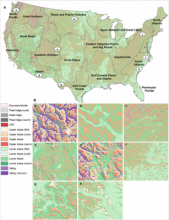Ecologically-relevant maps of landforms and physiographic diversity for climate adaptation planning

Key to understanding the implications of climate and land use change on biodiversity and natural resources is to incorporate the physiographic platform on which changes in ecological systems unfold. Here, we advance a detailed classification and high-resolution map of physiography, built by combining landforms and lithology (soil parent material) at multiple spatial scales. We used only relatively static abiotic variables (i.e., excluded climatic and biotic factors) to prevent confounding current ecological patterns and processes with enduring landscape features, and to make the physiographic classification more interpretable for climate adaptation planning. We generated novel spatial databases for 15 landform and 269 physiographic types across the conterminous United States of America. We examined their potential use by natural resource managers by placing them within a contemporary climate change adaptation framework, and found our physiographic databases could play key roles in four of seven general adaptation strategies. We also calculated correlations with common empirical measures of biodiversity to examine the degree to which the physiographic setting explains various aspects of current biodiversity patterns. Additionally, we evaluated the relationship between landform diversity and measures of climate change to explore how changes may unfold across a geophysical template. We found landform types are particularly sensitive to spatial scale, and so we recommend using high-resolution datasets when possible, as well as generating metrics using multiple neighborhood sizes to both minimize and characterize potential unknown biases. We illustrate how our work can inform current strategies for climate change adaptation. The analytical framework and classification of landforms and parent material are easily extendable to other geographies and may be used to promote climate change adaptation in other settings.
Theobald, D. M., D. Harrison-Atlas, W. B. Monahan, and C. M. Albano. 2015. Ecologically-Relevant Maps of Landforms and Physiographic Diversity for Climate Adaptation Planning. PLoS ONE 10:e0143619.
